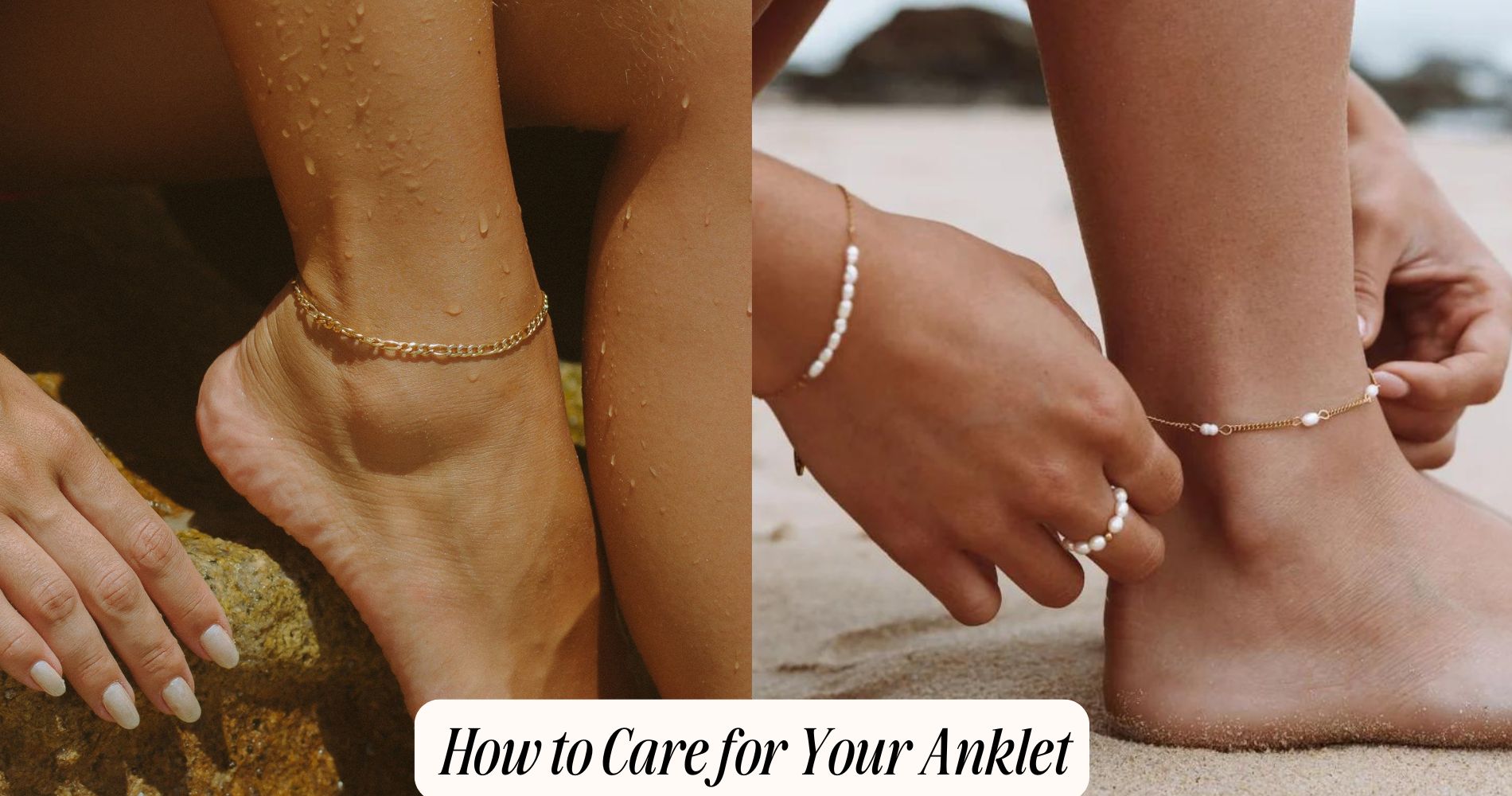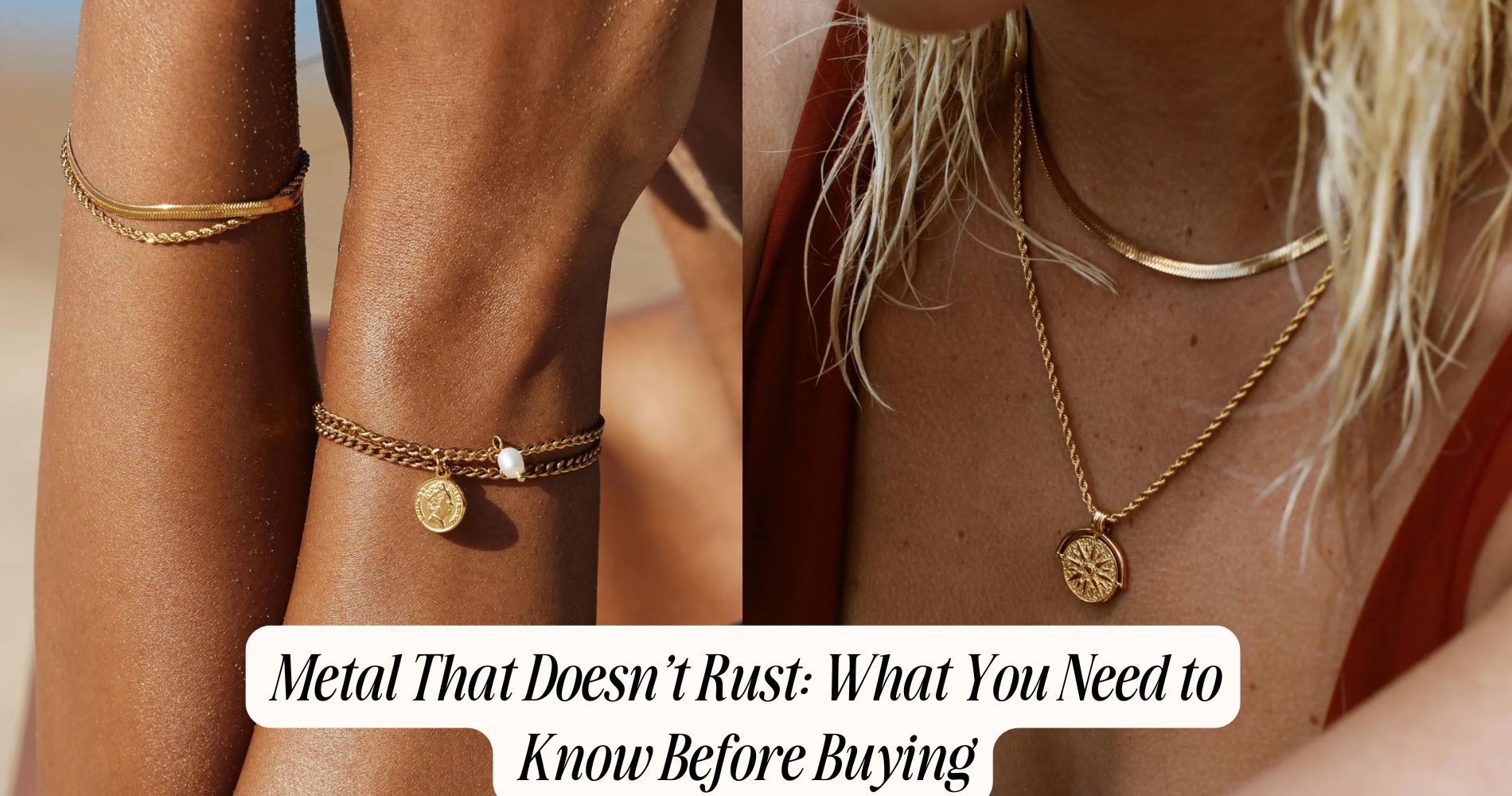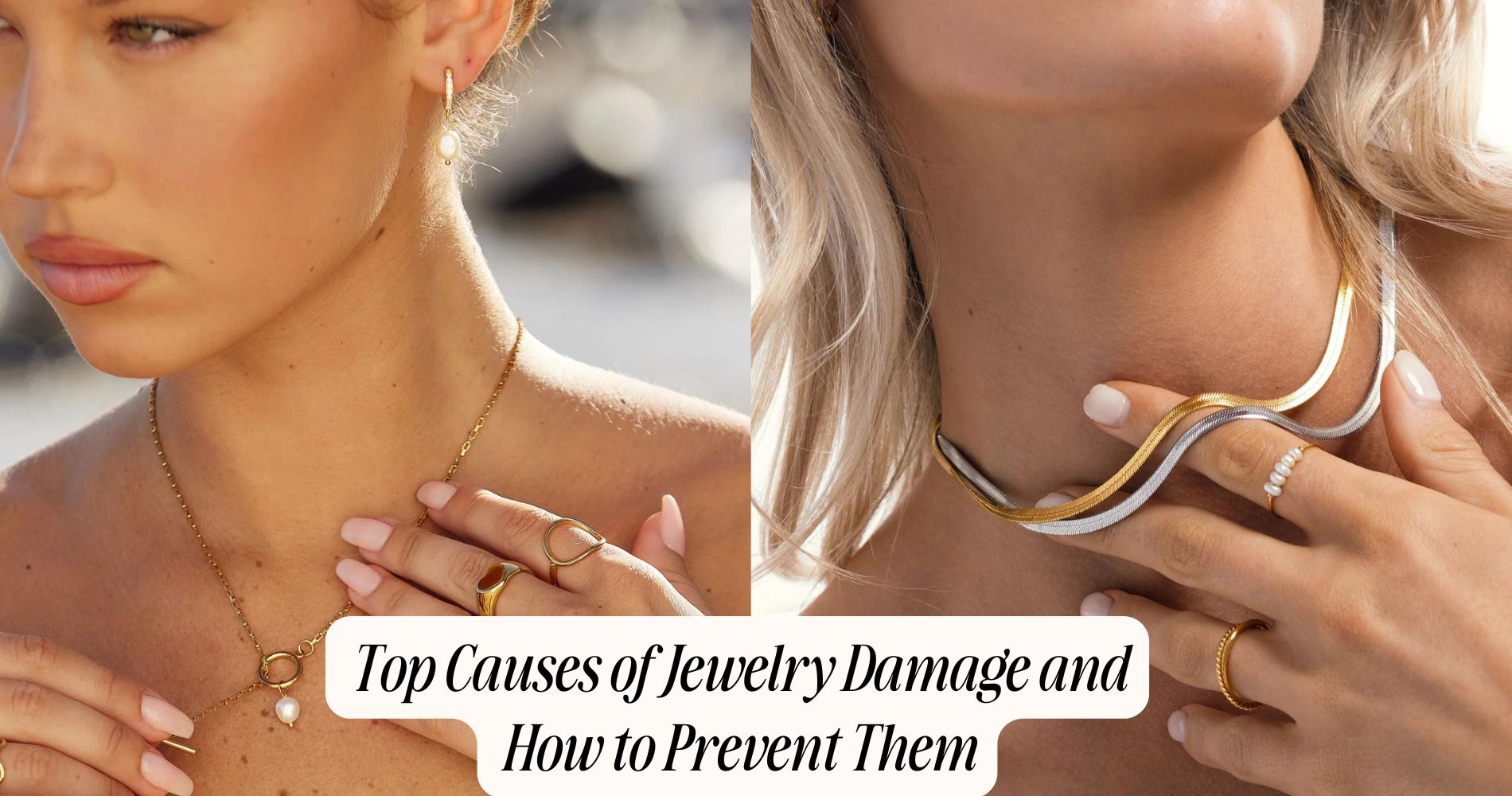
How to Care for Your Anklet
If you’re wondering how to care anklet, the first step is to identify its material for the appropriate cleaning method. For metal anklets, use a mild soap solution on a damp cloth and avoid any abrasives. Beaded anklets should be rinsed gently under lukewarm water. It’s essential to inspect your anklet for loose clasps or wear after each use and store it in a soft pouch to prevent scratches. Remember to remove your anklet before swimming or exercising to protect it from moisture damage. Regular maintenance includes cleaning metal pieces weekly and beaded or fabric styles every couple of weeks. To ensure your anklet remains in pristine condition, explore our Gold Ankle Bracelets collection for more tips and styles that can help you maintain your jewelry beautifully.
Types of Anklets
When it comes to choosing the right anklet, have you considered the various styles available? Each type offers unique aesthetics and versatility to suit your personal taste.
Beaded anklets, for instance, provide a playful yet elegant vibe, often featuring colorful beads that can match any outfit. Chain anklets, with their sleek metal links, add a touch of sophistication and can be easily layered with other ankle bracelets.
If you're looking to express your individuality, charm anklets allow you to attach meaningful charms that reflect your personality. Adjustable anklets are perfect for those who enjoy a customized fit, ensuring comfort throughout the day.
Metal anklets bring a classic appeal, often crafted from silver or gold, suitable for both casual and formal occasions. Fabric anklets offer a lightweight option, often adorned with vibrant patterns, making them ideal for summer wear.
For something truly special, consider personalized anklets, which can be engraved with initials or significant dates.
With such a variety of styles available, you can effortlessly find an anklet that not only enhances your look but also tells your unique story. Choose wisely, and let your anklet be an extension of yourself.
Cleaning Your Anklet
How do you keep your anklet looking its best? Regular cleaning is essential, especially since anklets can be made from a variety of materials, such as metal, leather, or fabric.
Start by identifying the material of your anklet, as this will determine the best cleaning approach.
For metal anklets, a mild soap solution works wonders. Mix a few drops of dish soap with warm water, dampen a soft cloth, and gently wipe down the surface. Avoid abrasive cleaners that can scratch the finish.
For leather anklets, use a damp cloth to remove dirt and sweat, followed by a leather conditioner to keep the material supple.
Fabric anklets may require a different approach. If they're machine washable, place them in a laundry bag to prevent snagging. If not, a mixture of water and a gentle fabric cleaner can be used.
Always rinse your anklet thoroughly after cleaning to remove any soap residue.
After cleaning, dry it properly to prevent moisture buildup, which can tarnish or damage the anklet materials.
Avoiding Common Damage
Regularly avoiding common damage to your anklet can greatly extend its lifespan and maintain its appearance. Different anklet materials, such as sterling silver, gold, and leather, require specific care to avoid deterioration.
For example, sterling silver can tarnish when exposed to moisture, so it's essential to remove your anklet before swimming or showering. Gold materials may scratch easily, especially if they come into contact with harder surfaces, so be mindful of where you wear your anklet.
Additionally, be cautious of common wear. Anklets can snag on clothing or furniture, leading to breakage. When engaging in physical activities, consider removing your anklet to prevent any potential damage.
For leather anklets, avoid exposing them to excessive heat or moisture, as these elements can cause them to warp or lose their shape.
Lastly, regularly inspect your anklet for signs of wear and tear. Look for loose clasps or frayed materials, and address these issues promptly to prevent further damage.
Storing Your Anklet Properly
Properly storing your anklet is essential to maintaining its beauty and longevity.
Always choose a safe location, like a jewelry box or drawer, where it won't get tangled or scratched.
Using soft pouches can prevent damage, and keeping it away from excessive moisture will help protect its materials from deterioration.
Choose a Safe Location
When it comes to storing your anklet, selecting a safe location is essential to maintain its beauty and integrity. First, consider the environmental conditions; your anklet shouldn't be exposed to harsh sunlight, humidity, or extreme temperatures. These factors can lead to tarnishing or damage over time. Instead, aim for a cool, dry space where the anklet can rest undisturbed.
Next, think about anklet placement. Avoid areas where it could get tangled with other jewelry or caught on items that may cause breakage. A dedicated drawer or a jewelry box with compartments can provide a safe environment for your anklet. If you don't have a box, even a small section of a drawer can work, as long as you guarantee it's free from clutter.
Lastly, be mindful of pets or children who might inadvertently damage your anklet. Placing it out of reach keeps it safe and helps prevent accidental mishaps.
Use Soft Pouches
To enhance the protection of your anklet while storing it, consider using soft pouches. These pouches, made from soft material like cotton or velvet, provide a gentle protective layer against scratches, dust, and other potential damage.
When you place your anklet inside a soft pouch, it minimizes contact with other jewelry and surfaces that could cause wear or tarnishing.
Choose pouches that are specifically designed for jewelry storage. Look for ones with a snug fit to prevent your anklet from moving around inside, which can lead to tangling or scratching.
If you have multiple anklets, consider color-coding your pouches or labeling them to easily identify which anklet is in which pouch.
When you're not wearing your anklet, always store it in a soft pouch to maintain its appearance and longevity.
Avoid placing it in a drawer or box without protection, as hard surfaces can lead to unwanted wear.
By taking this simple step, you'll guarantee your anklet remains in pristine condition, ready for whenever you want to wear it again.
Proper storage is a key element in caring for your jewelry, and soft pouches are an excellent solution.
Avoid Excessive Moisture
While you might love wearing your anklet during sunny days at the beach, it's essential to keep it away from excessive moisture when storing it.
Different anklet materials, such as metal, leather, or beads, can react negatively to moisture. For instance, metal anklets can tarnish or rust, while leather can become discolored or warped. Beads, especially if they're made of natural materials, may swell or degrade when exposed to dampness.
To protect your anklet, always make certain it's completely dry before storing it. If you've worn it in water, gently wipe it with a soft cloth to remove any moisture.
Consider using a dry, breathable pouch or a jewelry box with good ventilation for storage. Avoid placing it in areas prone to humidity, like bathrooms or damp basements, as these environments exacerbate moisture effects.
Protecting From Water and Humidity
To keep your anklet in pristine condition, it's crucial to remove it before swimming to prevent exposure to chlorine or saltwater, which can cause damage.
Additionally, store your anklet in a dry place to avoid the detrimental effects of humidity that may lead to tarnishing or corrosion.
Remove Before Swimming
If you're planning to hit the pool or beach, remember to remove your anklet first. Water can be damaging to many anklet materials, including metals, beads, and fabric. Chlorine and saltwater can lead to discoloration, corrosion, or even breakage, jeopardizing the integrity of your accessory.
Taking swimming precautions is essential to prolong the life of your anklet. Different anklet materials react variously to water exposure. For instance, silver and gold can tarnish when exposed to chlorine, while fabric or leather anklets may absorb water, leading to mold and mildew.
Even if your anklet is made from more water-resistant materials like silicone, it's still best to remove it before swimming. Additionally, the combination of water and sand can cause unwanted friction, potentially leading to scratches or wear.
Store in Dry Place
Proper storage plays a critical role in maintaining the beauty and longevity of your anklet. To protect it from water and humidity, you'll want to store it in a dry place. Moisture can lead to tarnishing, corrosion, or even deterioration of certain materials, so keeping humidity levels low is vital.
Consider your anklet's material selection when determining how to store it. For example, metal anklets can easily tarnish when exposed to moisture, while fabric or leather anklets may develop mold if not stored properly.
Use a soft, dry cloth to wrap your anklet before placing it in a jewelry box, making sure it's away from any damp areas such as bathrooms or kitchens.
If you live in a humid climate, think about using silica gel packets in your storage container to absorb excess moisture. Regularly check your storage environment and keep it well-ventilated.
Polishing Techniques
Regular polishing can greatly enhance the shine and longevity of your anklet. To achieve the best results, start by using high-quality polishing cloths specifically designed for jewelry. These cloths are gentle yet effective, preventing scratches while restoring that brilliant luster.
Before polishing, verify your anklet is clean and free from dirt or grime. You can use a mild soap solution and a soft brush to clean it gently. Once it's dry, it's time to polish.
Take your polishing cloth and rub it gently against the surface of the anklet. Use circular motions for even coverage, focusing on areas that show signs of tarnish or dullness.
For more stubborn tarnish, consider using polishing solutions formulated for your anklet's material. Apply a small amount of the solution to your polishing cloth, then gently rub it onto the anklet. Be careful not to use excessive pressure, as this can cause damage.
After polishing, wipe the anklet with a clean section of the cloth to remove any residue from the solution. Regularly incorporating these polishing techniques will keep your anklet looking vibrant and new for years to come.
Regular Maintenance Tips
To keep your anklet looking its best, regular cleaning and proper storage are essential.
Use a gentle cloth to wipe it down after each wear, and store it in a soft pouch or jewelry box to prevent scratches and tangling.
Cleaning Techniques
Keeping your anklet looking its best requires a bit of routine care, and cleaning it regularly is key. The cleaning frequency depends on the anklet materials; for instance, metal anklets benefit from a weekly wipe-down, while those made from beads or fabric may need a gentler approach every couple of weeks.
To clean metal anklets, use a soft cloth to remove dirt and skin oils. If tarnishing occurs, a specialized metal polish can restore shine.
For beaded or fabric anklets, gently rinse them under lukewarm water and use a mild soap. Avoid harsh chemicals, as these can damage the materials.
If your anklet features gemstones or pearls, take extra care. Use a soft brush or cloth to clean these delicate components, and always dry them thoroughly to prevent moisture damage.
Remember, how often you clean your anklet directly impacts its longevity and appearance. Following these cleaning techniques will help you maintain your anklet, ensuring it stays a stunning accessory for years to come.
Regular maintenance not only enhances its beauty but also protects your investment in quality anklet materials.
Storage Recommendations
Your anklet deserves a proper storage solution to maintain its condition and appearance. Start by identifying the anklet materials; different materials require different care. For instance, metal anklets can tarnish if exposed to moisture, while leather or fabric anklets can warp or stain.
When storing your anklet, consider using a soft pouch or a dedicated jewelry box with compartments. This prevents scratches and tangling, especially if you own multiple anklets. If your anklet features beads or charms, make certain they're secured to avoid breakage.
For traveling tips, always pack your anklet in a protective case or wrap it in a soft cloth to keep it safe from damage. Avoid placing it in your luggage's main compartment where it might get crushed; instead, carry it in your purse or a carry-on.
Lastly, routinely check on your anklet's condition. Inspect for any loose clasps or damaged materials.
Repairing Minor Damage
Minor damage to an anklet can be an unexpected source of frustration, but addressing it promptly can restore its beauty and functionality.
Start by identifying the type of damage; whether it's a broken chain, loose clasp, or missing beads, knowing the issue helps you choose the right anklet repair techniques.
For metal anklets, you can often fix minor breaks by using pliers to reconnect links, guaranteeing they're securely fastened.
If your anklet is made from materials like leather or fabric, consider applying a strong adhesive or sewing the damaged area to maintain its integrity. Be careful not to use too much glue, as it may leave visible residue.
When it comes to beaded anklets, you can replace missing beads by carefully removing the damaged section and re-stringing it with new beads.
Look for replacements that match the original design to keep your anklet cohesive.
Lastly, always clean the area around the repair to guarantee the best adhesion and finish.
Seasonal Care Considerations
Regularly evaluating your anklet's condition throughout the changing seasons is vital for its longevity. The weather impacts your anklet in various ways, and understanding these influences can help you maintain its beauty and functionality.
During the humid summer months, sweat and moisture may cause tarnishing in metal anklets or lead to skin irritation. It's wise to remove your anklet before swimming or exercising to prevent damage.
As the colder months approach, be mindful of how winter weather can affect your jewelry. If you wear your anklet over thicker socks or boots, it may become stretched or misshapen. Additionally, salt from icy roads can corrode certain materials, so consider giving your anklet a gentle wash after exposure to such conditions.
Keep an eye on seasonal trends, too. If your anklet features gemstones, fluctuating temperatures might affect their stability. Inspect the settings and clasps regularly to ascertain everything remains secure.
When to Seek Professional Help
Even with diligent care and seasonal awareness, there may come a time when your anklet needs professional attention. If you notice any signs of damage, such as frayed links or a broken clasp, it's vital to seek help immediately.
Damage can worsen if left unattended, compromising the anklet's integrity and potentially leading to loss.
Another reason to consult a professional is if you're unsure about anklet sizing. If your anklet feels too loose or tight, an expert can provide guidance on adjustments or resizing.
Proper sizing guarantees both comfort and longevity, preventing unnecessary wear and tear.
For intricate designs or materials like gemstones and precious metals, professional cleaning is necessary. Home cleaning methods can sometimes be too abrasive, risking the anklet's finish.
A jeweler can use specialized tools and techniques to restore your piece to its original luster safely.
Frequently Asked Questions
Can I Wear My Anklet While Exercising or Dancing?
Yes, you can wear your anklet while exercising or dancing, but make certain it's durable enough for movement. Choose materials that won't break easily, and always prioritize exercise safety to avoid injuries or damage to your anklet.
What Materials Are Best for Sensitive Skin?
For sensitive skin, you should opt for hypoallergenic materials like titanium or stainless steel. Conduct allergy testing before wearing new jewelry to guarantee comfort and minimize irritation, helping you enjoy your accessories without worry.
How Do I Choose the Right Anklet Length?
To choose the right anklet length, measure your ankle's circumference and consider different anklet styles. Typically, anklets fall between 9 to 11 inches, but adjust based on your comfort and desired fit for each style.
Is It Safe to Wear Anklets During Pregnancy?
Wearing anklets during pregnancy is generally safe, but you should consider anklet safety. Choose lightweight materials and avoid tight designs. Always consult your healthcare provider for personalized pregnancy precautions to guarantee you and your baby remain comfortable.
Can Anklets Be Personalized or Customized?
Absolutely, you can personalize anklets! Consider various anklet engraving options for a unique touch and explore charm selection ideas to reflect your style or commemorate special moments. Customization makes your anklet truly one-of-a-kind.
Conclusion
Caring for your anklet requires attention and regular maintenance to keep it looking its best. By understanding the different types of anklets, cleaning techniques, and proper storage methods, you can prevent common damage and prolong its life. Always protect your anklet from water and humidity, and don't hesitate to repair minor issues as they arise. With these tips in mind, you'll guarantee your anklet remains a stunning accessory for years to come.
























Leave a comment
This site is protected by hCaptcha and the hCaptcha Privacy Policy and Terms of Service apply.